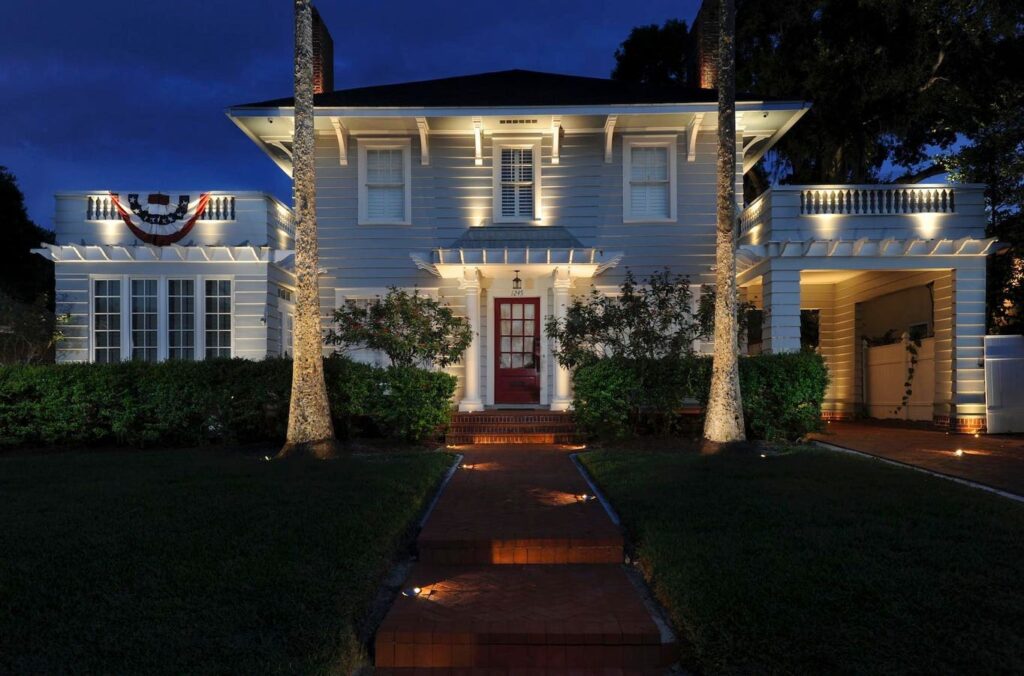Outdoor lighting is an important consideration for homeowners looking to upgrade their curb appeal. It’s also somethi
ng homeowners are considering when looking for ways to create the perfect outdoor entertaining hub. In fact, the most recent Houzz Renovation Trends Report reveals that one of the most popular outdoor renovation projects is upgrading lighting systems.
Outdoor Lighting: Part 1 covered lighting mistakes. Part 2 focuses on tips and tricka to take your outdoor lighting to another level.
Decide How You Want To Use The Space
When evaluating your outdoor lighting, consider not just how it looks, but how it feels. “You may be tempted to treat outdoor lighting as an afterthought, layering in a few spotlights or path lights without a plan,” says Chris Apfelstadt, CEO and lighting designer at Light Up Columbus Instead, he recommends that you start begin by asking yourself how you want to use the space — for example, do you plan to entertain guests or is this a peaceful garden-focused retreat? Your lighting should reflect your intention for the outdoor space.
Consider The View From Inside
Another tip is to consider the view from the inside of your home as you’re looking out. “A successful outdoor lighting plan doesn’t just illuminate the yard—it enhances the atmosphere from key interior spaces like the kitchen or bedroom,” Apfelstadt says. “A warm glow in the garden or subtle uplighting on trees can extend the perceived size of your home and create a more cohesive indoor-outdoor experience.” He recommends thinking in layers: for example, ambient lighting for mood, task lighting for function, and accent lighting for focal points. “Don’t forget about control—dimmers, zones, and smart timers help your lighting adapt to different needs and times of day,” Apfelstadt adds.
You can certainly apply a lot of these principles yourself, But he notes that a truly great lighting designer can work wonders. “This individual will instinctively pull all of these elements together, creating a lighting plan that reflects your lifestyle, your views, and the emotional tone you want your home to have after dark,” Apfelstadt says.
Decide What Type Of Lighting is Right For Your Outdoor Space
Kyle Beach, COO of Wonderly Lights, provided invaluable insight for Outdoor Lighting Mistakes. He agrees with Apfelstadt that you need to consider the purpose of your outdoor space (hosting, quiet reflection, or elevating the home’s visual appearance).
“With living areas such as patios or terraces, layered ambient lighting, wall sconces, bistro lights, or surrounding deck lighting, can extend your living space and establish a warm, welcoming atmosphere,” Beach says. For pathways and stairs, he recommends low-voltage fixtures, as they offer subtle safety without visual clutter. “Planting areas and ornamental trees benefit from uplighting designed to highlight texture, form and seasonal beauty,” Beach explains.
His team always recommends a layered approach, which combines ambient, architectural, and accent lighting, as this will add both depth and visual rhythm across the property. “Above all, invest in weather-rated, professional-grade fixtures from the start, since, in our experience, homeowners who prioritize quality not only achieve superior design but avoid the cycle of wasted money replacing sun-faded, corroded, or underperforming fixtures every few years,” Beach says.
Mixing And Marching Different Types Of Lighting
As you’re trying to mix and match different types of lighting, identify your focal points. “Consider the elements of your property you want to emphasize, such as a striking tree, architectural detail, or the main entryway,” Beach says.
After establishing the focal points, he says you can build a layered lighting plan that balances beauty and function. “Introduce functional lighting in areas where visibility and safety are essential, including pathways, outdoor kitchens, and gathering spaces.” And the final step is to incorporate accent lighting to add depth and visual interest. “Draw attention to features like water elements, ornamental trees, or sculptural plantings, as a thoughtful mix of these lighting types creates a cohesive, inviting outdoor environment,” Beach recommends.
Consistency is key: Beach says you should unify the space through shared materials, finishes, and color temperature (typically a warm 2700K–3000K). He suggests avoiding overly decorative or trendy fixtures, noting they can quickly date your outdoor space. “Instead, select timeless forms built from commercial-grade metals, solid brass, or architectural bronze—materials that age beautifully and last for decades,” Beach says.
When it’s done well, Beach explains that outdoor lighting is less about brightness and more about balance. “Strategic darkness, shadow play, and restrained use of light can transform an ordinary space into something atmospheric and intentional,” he says.
Lighting Tips For Those On A Budget
Even if you don’t have a lot to spend on outdoor lighting, Beach warns against compromising with short-lived or disposable fixtures.” His team encourages a phased investment in quality and he prioritizes lighting the areas that offer the highest functional and visual impact, such as the entryway, main entertaining spaces, and focal points in the landscape.
“Opt for professional-grade fixtures from trusted architectural lighting brands, which have a higher upfront cost, but are designed to endure harsh climates, resist corrosion, and deliver consistent performance for a decade or more,” Beach says. On the other hand, he warns that cheaper alternatives—especially those made of plastic or thin aluminum—can degrade quickly, need to be replaced frequently and end up costing more.
“If you’re working within a budget, install in stages: begin with foundational lighting that addresses safety, property value, and usability, then expand to accent and ambient layers over time,” Beach concludes.
Read the full article here

